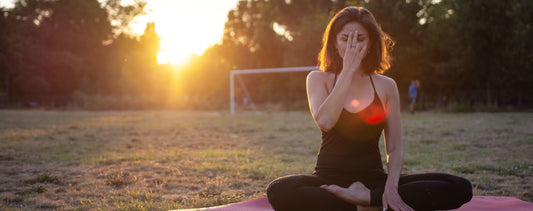Looking to simultaneously relax and energize your mind and body? Your answer may be an ancient yogic breathing technique called Ujjayi.
Ujjayi (pronounced oo-jai) is commonly translated as “victorious breath,” and has been used for thousands of years to enhance hatha yoga practice. Also commonly referred to as the “oceanic breath,” the sound that Ujjayi provides helps us to synchronize breath with movements during yoga, making the entire yoga practice more rhythmic.
When you’re practicing hatha yoga: Try focusing on Ujjayi breathing while practicing yoga to help you stay focused and centered as you flow from one posture to the next.
When exercising: Ujjayi is also useful when you’re doing aerobic exercise such as running or cycling. In fact, some Olympic-level athletes have introduced Ujjayi into their training routines to improve their respiratory efficiency. Experiment with this breath technique when you’re working out and see if it reduces wear and tear on your body.
When you’re nervous: The slow and rhythmic nature of the Ujjayi breath is incredibly helpful to calm nerves. Next time you find yourself with a case of the jitters, try some yogic breathing to settle the worries.
Find balance anywhere, anytime with the new Chopra App. Download it now for hundreds of personalized guided meditations at your fingertips.
Ujjayi (pronounced oo-jai) is commonly translated as “victorious breath,” and has been used for thousands of years to enhance hatha yoga practice. Also commonly referred to as the “oceanic breath,” the sound that Ujjayi provides helps us to synchronize breath with movements during yoga, making the entire yoga practice more rhythmic.
Benefits of Ujjayi Breathing
Ujjayi has a balancing influence on the entire cardiorespiratory system, releases feelings of irritation and frustration, and helps calm the mind and body. With Ujjayi, there are so many benefits, providing good value for a simple practice. Here are a few benefits you may enjoy as a result of practicing the Ujjayi breath:- Increases the amount of oxygen in the blood
- Builds internal body heat
- Relieves tension
- Encourages free flow of prana
- Regulates blood pressure
- Helps yoga practitioner to maintain a rhythm while they practice
- Builds energy
- Detoxifies mind and body
- Increases feelings of presence, self-awareness, and meditative qualities
How to Perform Ujjayi Breath
Want to get started now? Follow these steps:- Seal your lips and start to breath in and out through your nose.
- Take an inhalation through your nose that is slightly deeper than normal. Exhale slowly through your nose while constricting the muscles in the back of your throat.
Getting the Ujjayi Sound Right
If you’re having trouble getting the right sound for your breath, try this:- With your mouth open, try exhaling the sound “HAAAAH”—it’s similar to the sound you make when you’re trying to fog up a mirror. Get comfortable with this sound to get the hang of the practice.
- Close your mouth and attempt a similar sound, feeling the outflow of air through your nasal passages. Once you have mastered this on the outflow, use the same method for the in-flow breath, gently constricting the back of your throat as you inhale.
When to Use Ujjayi Breath
When you’re agitated: Since the Ujjayi breath is especially good for settling agitation and stress, and balancing the mind, try shifting into Ujjayi breath whenever you find yourself becoming aggravated or stressed. You should notice a soothing effect promptly.When you’re practicing hatha yoga: Try focusing on Ujjayi breathing while practicing yoga to help you stay focused and centered as you flow from one posture to the next.
When exercising: Ujjayi is also useful when you’re doing aerobic exercise such as running or cycling. In fact, some Olympic-level athletes have introduced Ujjayi into their training routines to improve their respiratory efficiency. Experiment with this breath technique when you’re working out and see if it reduces wear and tear on your body.
When you’re nervous: The slow and rhythmic nature of the Ujjayi breath is incredibly helpful to calm nerves. Next time you find yourself with a case of the jitters, try some yogic breathing to settle the worries.
Find balance anywhere, anytime with the new Chopra App. Download it now for hundreds of personalized guided meditations at your fingertips.






















